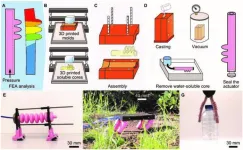(Press-News.org) By repeatedly scanning the brains of a small group of patients for a year and a half, Weill Cornell Medicine researchers have identified a distinct pattern of neuronal interactions that appears to predispose some people to developing depression.
Published Sept. 4 in Nature, the work highlights the potential of a new “deep scanning” approach to help predict a person’s susceptibility to depression and other neuropsychiatric conditions and may guide the development of novel treatments.
Neuroscientists have long relied on functional magnetic resonance imaging (fMRI) to identify patterns of activity in the brain by measuring changes in blood flow. This has been an invaluable tool for studying brain organization at the individual level.
Individual brain activity patterns differ not only between people, but over time in a single person. That’s especially problematic for studying conditions such as depression. “Depression is, by definition, an episodic psychiatric syndrome, it’s characterized by periods of low mood mixed in with periods of wellness,” says senior author Dr. Conor Liston, professor of psychiatry in the Department of Psychiatry and professor of neuroscience at Feil Family Brain and Mind Research Institute at Weill Cornell Medicine. “What are the mechanisms that control those transitions over time?” he asks.
Pre-wired for Depression?
To address that, the investigators enrolled a handful of patients with diagnosed depression as well as a larger group of unaffected controls and scanned their brains with fMRI dozens of times over several months.
The deep scanning approach revealed that in a majority of volunteers with depression diagnoses, a brain feature called the salience network is nearly two-fold larger than in controls who didn’t experience clinical depression. The salience network is a group of brain regions in the frontal cortex and striatum thought to be involved in reward processing and determining which stimuli are most worthy of attention.
“Having a larger salience network appears to increase the risk for depression—the effect is an order of magnitude larger than what we usually see in fMRI studies,” says Dr. Liston, who is also a psychiatrist at NewYork-Presbyterian/Weill Cornell Medical Center.
Working with a large team of international collaborators, the researchers extended the work to look at data from hundreds of other patients whose brains had been scanned less frequently. Those data suggested that people with larger salience networks in childhood are more likely to develop depression later in life, as if they were pre-wired for the condition.
Next Steps
Previous work has linked the salience network to the brain’s processing of rewards. “It being implicated in depression kind of makes sense, because one of the main deficits in depression is anhedonia, which is the inability to feel pleasure and enjoy everyday activities,” says Dr. Charles Lynch, assistant professor of neuroscience in the Department of Psychiatry at Weill Cornell Medicine and lead author on the new study.
While the scientists emphasize that the results need to be reproduced and extended before they can be applied directly in the clinic, the work has already provided major validation of the deep scanning approach.
“For years, many investigators assumed that brain networks look the same in everybody,” Dr. Lynch says. “But the findings in this work build on a growing body of research indicating that there are fundamental differences between individuals.”
He adds that the team now hopes to study the effects of various depression treatments on the activity of brain networks and perhaps extend their work to other neuropsychiatric conditions as well.
Many Weill Cornell Medicine physicians and scientists maintain relationships and collaborate with external organizations to foster scientific innovation and provide expert guidance. The institution makes these disclosures public to ensure transparency. For this information, please see the profile for Dr. Conor Liston.
END
Brain scanning approach shows wiring of depression
2024-09-04
ELSE PRESS RELEASES FROM THIS DATE:
Heart drug improved exercise tolerance in clinical trial of patients with hypertrophic obstructive cardiomyopathy
2024-09-04
Exercise intolerance is often severe among patients with cardiovascular disease and can impose significant limitations on their physical abilities and quality of life. Medications known as cardiac myosin inhibitors (CMIs) are being developed to help patients with hypertrophic obstructive cardiomyopathy (HOCM), a disease in which the heart muscle becomes thickened leading to reduced blood flow out of the heart. In a new analysis led by researchers from Mass General Brigham, investigators probed multiple exercise response ...
Menstrual cycle influences the spread of mutant cells in mammary tissue
2024-09-04
Leuven/Amsterdam/Cambridge, 5 September– A team of researchers at the VIB-KU Leuven Center for Cancer Biology, the Netherlands Cancer Institute and Oncode Institute and the University of Cambridge have discovered that a defensive mechanism connected to the menstrual cycle plays a role in spreading mutant cells within mammary tissue. A new study published in Nature describes how the growth and subsequent removal of extra milk ducts in breast tissue during the menstrual cycle can contribute to the spread of mutant cells leading to large mutant fields prone to develop tumors.
Although tissue in healthy individuals may look completely normal, ...
Study shows how oceans are key to addressing global challenges
2024-09-04
New research shows how oceans can be used to help address major challenges such as the shortage of antimicrobial medicines, solutions for plastic pollution and novel enzymes for genome editing.
In the past 20 years, scientists have greatly increased the number of microbial genomes they have collected from the ocean. However, using this information for biotechnology and medicine has been difficult.
For this new study, led by BGI Research in China in collaboration with the Shandong University, Xiamen University, ...
Immune cells prevent lung healing after viral infection
2024-09-04
Investigators involved in a multicenter study co-led by Cedars-Sinai discovered a pathway by which immune cells prevent the lungs’ protective barrier from healing after viral infections like COVID-19. The findings, published in Nature may lead to new therapeutic treatment options.
The COVID-19 pandemic revealed how viral infections can cause long-lasting effects—a condition called long COVID. Also known as post-acute sequelae of SARS-CoV-2, long COVID has left a devastating trail of people who continue to live with ...
KERI overcomes from overseas dependence on drive system technology for machine tools!
2024-09-04
Korea Electrotechnology Research Institute (KERI) has succeeded in domestically developing the ‘CNC driving system’ technology, a core component of machine tools—often referred to as "Mother Machines," the machines that make other machines.
The CNC (Computer Numerical Control) system is an electronic module that processes numerical information via a computer and automatically controls all functions of machine tools, including position, speed, and rotation of a machine tool. In a computer, it plays a role similar to that of a CPU.
A major challenge ...
Digital Science unveils Papers Pro: Revolutionizing scholarly research with advanced AI-powered features
2024-09-04
Digital Science today announces the launch of Papers Pro, an AI-enhanced premium version of its acclaimed reference manager, Papers.
As part of the ReadCube suite of literature solutions, Papers Pro is designed to make researchers and students more productive in their daily tasks by integrating cutting-edge AI tools to transform how they discover, organize, read, annotate, share and cite research materials.
Search and discovery has always been a core part of the Papers workflow. The launch of Papers Pro introduces new search capabilities, powered by Dimensions, one of the world’s largest ...
PCORI offers up to $100 million for new research promoting healthy children and youth
2024-09-04
Sept. 4, 2024
WASHINGTON, D.C. – The Patient-Centered Outcomes Research Institute (PCORI) today began inviting proposals through eight new funding opportunities, including three PCORI Funding Announcements (PFAs) for patient-centered comparative clinical effectiveness research (CER). One PFA is offering up to $100 million to support CER studies promoting healthy children and youth, a demographic representing more than a third of the U.S. population and facing a range of mental and physical health challenges.
“These ...
Newly discovered gene may influence longevity
2024-09-04
It turns out that a particular gene has a great influence on longevity, a new study from the University of Copenhagen concludes. This may pave the way for new treatment.
Sleep, fasting, exercise, green porridge, black coffee, a healthy social life …
There is an abundance of advice out there on how to live a good, long life. Researchers are working hard to determine why some people live longer than others, and how we get the most out of our increasingly long lives.
Now researchers from the Center for Healthy Aging, Department of Cellular and Molecular Medicine at the University of Copenhagen have made a breakthrough. They have discovered that ...
SwRI signs MOU with Blade Energy Partners to support carbon dioxide sequestration research
2024-09-04
SAN ANTONIO — September 4, 2024 — Southwest Research Institute has signed a memorandum of understanding (MOU) with Blade Energy Partners, establishing a new research collaboration focused on advancing carbon dioxide storage technology to reduce greenhouse gas emissions.
Carbon capture, utilization, and storage (CCUS) refers to the practices of capturing CO2 from its industrial sources or the atmosphere, transport it using pipelines and other means, using it as alternative fuel or other industrial applications, and storing it for later use. The drive to meet net-zero greenhouse gas emissions goals and ...
Integrated design and fabrication of pneumatic soft robot actuators in a single casting step
2024-09-04
A research paper by scientists at University of Coimbra proposed an integrated approach targeting the design and fabrication of pneumatic soft actuators in a single casting step. Molds and sacrificial water-soluble hollow cores are printed using fused filament fabrication.
The new research paper, published on Jul. 17 in the journal Cyborg and Bionic Systems, presented an integrated process for the design and fabrication of soft robot actuators in a single casting. The author proved the availability, versatility, and effectiveness of the proposed methods, contributing to accelerating the design and fabrication of soft robots.
Bio-inspired soft robots have already shown the ability to handle ...




